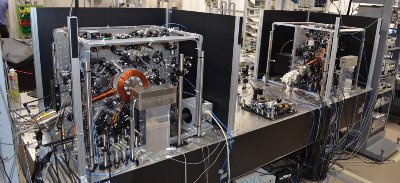May 1, 2015 Research Highlight Physics / Astronomy
Cryogenic clocks keep time
Atomic clocks with an unprecedented level of synchronization accuracy could allow more sensitive detection of gravity variations
 Figure 1: A pair of cryogenic optical lattice clocks can be synchronized at an accuracy of one part in two quintillion. © 2015 Hidetoshi Katori, RIKEN Quantum Metrology Laboratory
Figure 1: A pair of cryogenic optical lattice clocks can be synchronized at an accuracy of one part in two quintillion. © 2015 Hidetoshi Katori, RIKEN Quantum Metrology Laboratory
A pair of atomic clocks that can be synchronized at the highest accuracy ever achieved have been constructed and demonstrated by RIKEN researchers1. The clocks are so accurate that it would take 16 billion years for them to drift apart by a single second.
Atomic clocks are used as a highly precise basis for our time system, as well as for a range of scientific applications, from the global positioning system to detecting variations in the frequency of pulsars and in relativistic particle experiments. Although highly accurate, the ultimate accuracy of conventional atomic clocks, such as the cesium-beam atomic clock and the rubidium clock, is limited by electromagnetic perturbations from their environment.
Optical lattice clocks, which use atoms trapped by laser beams as the basis for timekeeping, are capable of even higher accuracy. Yet these systems are also susceptible to perturbations due to heat radiating from surrounding objects.
A team of researchers led by Hidetoshi Katori from the RIKEN Quantum Metrology Laboratory and RIKEN Center for Advanced Photonics has now overcome these interference problems by cooling a pair of optical lattice clocks based on strontium atoms to −178 degrees Celsius (Fig. 1). “Thermal radiation from surrounding walls has been the biggest source of uncertainty for optical lattice clocks with strontium atoms,” explains Katori. “Cryogenic clocks cut this uncertainty by two orders of magnitude.”
The researchers used a laser to generate a one-dimensional optical lattice with an ‘egg-box’-like profile and trapped individual strontium atoms in the egg cups. The laser wavelength was then tuned to a ‘magic’ wavelength at which the laser field has no effect on the oscillation of the atoms, and the optical lattice was used as a conveyor belt to transport the atoms into a cryo-chamber, where the timing measurements were made.
Comparisons of time measurements taken over a month revealed that the clocks were in agreement to one part in two quintillion, or one in 0.5×1018. This is the first time that clocks have been synchronized at this level of accuracy.
One promising application for this clock is in the measurement of tiny variations in the Earth’s gravitational field—an application that exploits the slowing of time that occurs in a stronger gravitational field described by Einstein’s general theory of relativity.
“At an accuracy of one in 1018, a pair of clocks can detect a one centimeter height difference on Earth,” says Katori. “To demonstrate this, we are now measuring the frequency difference between two clocks located 15 kilometers apart.”
References
- 1. Ushijima, I., Takamoto, M., Das, M., Ohkubo, T. & Katori, H. Cryogenic optical lattice clocks. Nature Photonics 9, 185–189 (2015). doi: 10.1038/nphoton.2015.5
